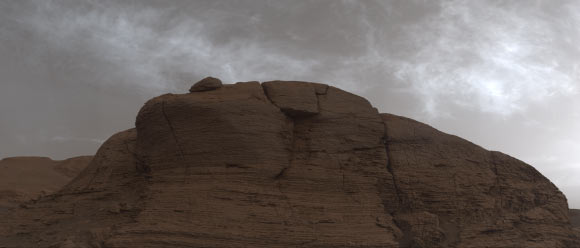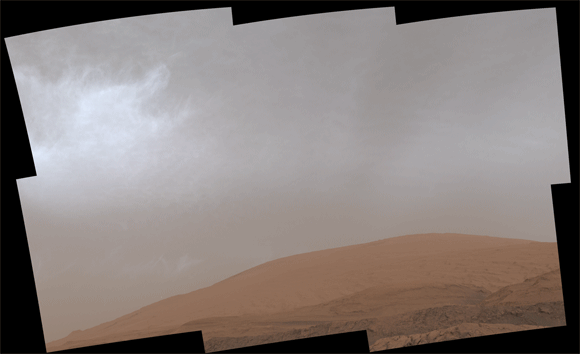In March 2021, NASA’s Curiosity rover observed clouds made of carbon dioxide (CO2) ice at high altitudes in the atmosphere of Mars.

Curiosity captured these clouds just after sunset on March 19, 2021, the 3,063rd Martian day, or sol, of the rover’s mission. The image is made up of 21 individual images stitched together and color corrected so that the scene appears as it would to the human eye. Image credit: NASA / JPL-Caltech / MSSS.
Clouds are typically found at the equator of Mars in the coldest time of year, when the planet is the farthest from the Sun in its oval-shaped orbit.
But two Earth years ago, the Curiosity team members spotted clouds in the Martian atmosphere earlier than expected.
This year, they were ready to start documenting these early clouds from the moment they first appeared in January.
What resulted are images of wispy puffs filled with ice crystals that scattered light from the setting Sun, some of them shimmering with color.
The researchers also found that the early-arrival clouds are actually at higher altitudes than is typical.
Most Martian clouds hover no more than about 60 km (37 miles) in the sky and are composed of water ice.
But the clouds Curiosity has imaged are at a higher altitude, where it’s very cold, indicating that they are likely made of frozen carbon dioxide.

This animated image shows clouds drifting over Mount Sharp on Mars, as viewed by Curiosity on March 19, 2021. Each frame of the scene was stitched together from six individual images. Image credit: NASA / JPL-Caltech / MSSS.
Viewed just after sunset, their ice crystals catch the fading light, causing them to appear to glow against the darkening sky.
These twilight clouds, also known as noctilucent clouds, grow brighter as they fill with crystals, then darken after the Sun’s position in the sky drops below their altitude. This is just one useful clue scientists use to determine how high they are.
Even more stunning are iridescent, or ‘mother of pearl,’ clouds.
“If you see a cloud with a shimmery pastel set of colors in it, that’s because the cloud particles are all nearly identical in size,” said Dr. Mark Lemmon, an atmospheric scientist with the Space Science Institute.
“That’s usually happening just after the clouds have formed and have all grown at the same rate.”
“These clouds are among the more colorful things on the Red Planet.”
“If you were skygazing next to Curiosity, you could see the colors with the naked eye, although they’d be faint.”
“I always marvel at the colors that show up: reds and greens and blues and purples.”
“It’s really cool to see something shining with lots of color on Mars.”
_____
This article is based on text provided by the National Aeronautics and Space Administration.







